Scaling a coaching business in Toronto presents both exciting opportunities and significant challenges. With a diverse population seeking guidance in areas like business, wellness, and personal growth, the competition is fierce. So, how do you stand out in such a crowded market? How do you transition from one-on-one coaching to building a thriving business with a growing client base?
The key to success lies in a clear and actionable strategy. With the right approach, you can turn your coaching passion into a successful and scalable business. Scaling isn’t about doing more, it’s about making smarter, more strategic decisions and leveraging the right tools to foster sustainable growth.
This guide’ll take you through each essential step for scaling your coaching business. From defining your niche and setting achievable goals to implementing effective marketing strategies and automating time-consuming tasks, we’ll cover everything you need to know to grow your coaching business in Toronto’s dynamic market.
Step-by-Step Guide to Scaling Your Coaching Business in Toronto
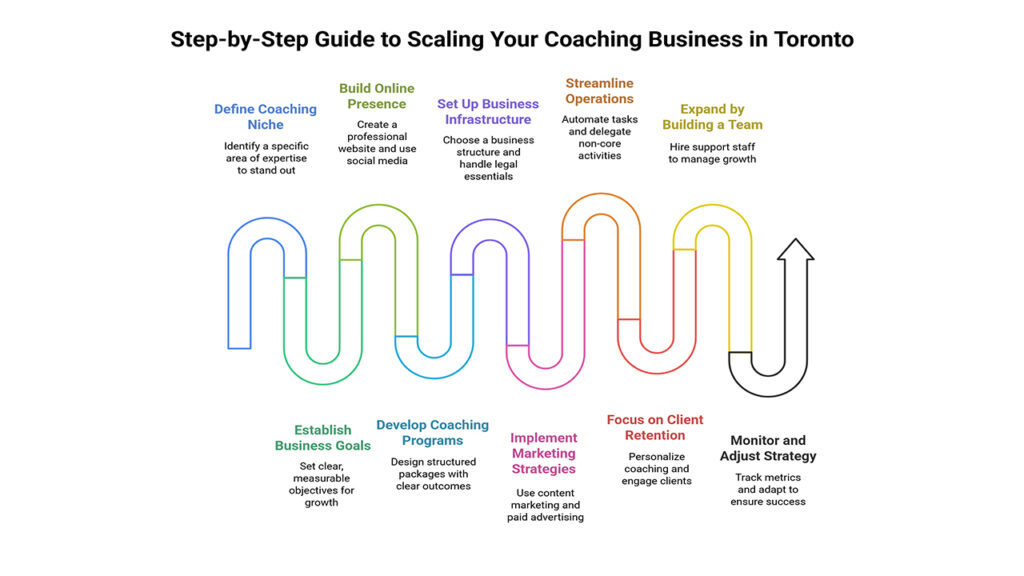
Step 1: Define Your Coaching Niche
Why Specializing is Key
In Toronto’s competitive coaching market, trying to be everything to everyone can work against you. Specializing in a specific coaching niche, like leadership, wellness, or executive coaching, helps you stand out and attract the right clients. By focusing on a particular area, you position yourself as an expert, which builds trust with your audience. When you narrow your focus, clients know exactly what they’ll get from you, and that clarity can make them more likely to reach out.
Think of it like this: Imagine you’re looking for a fitness coach. Would you trust someone who claims to help with every type of exercise, or would you rather work with someone who specializes in strength training or weight loss? Specializing makes you the go-to person for a specific need.
How to Choose Your Niche
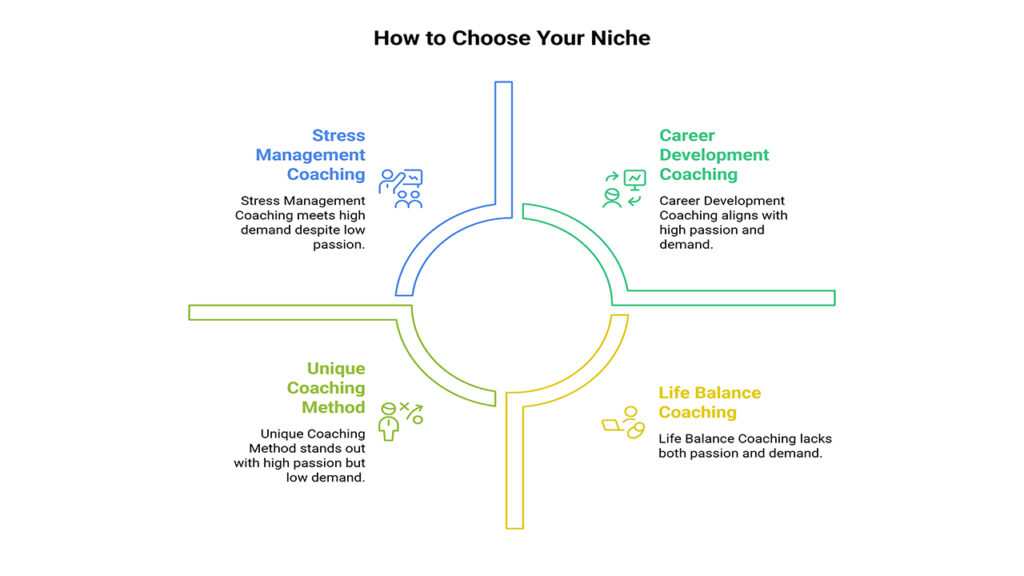
Now, how do you figure out what niche is right for you? It all starts with passion and demand. Here’s how you can find the perfect fit:
- Assess What You Love: What aspect of coaching excites you the most? You may enjoy helping people break their career barriers or guiding others toward a healthier lifestyle. The best niche will align with your interests and strengths.
- Research the Market: Toronto has a diverse population, and there are plenty of coaching areas in demand. Look at what people are searching for. Are they seeking business, career development, stress management, or life balance coaching?
- Find Your Unique Angle: Once you’ve identified a potential niche, consider what sets your approach apart. Can you combine coaching with a personal experience or a specific method that sets you apart from others in your niche?
- Test and Refine: Don’t be afraid to try different coaching areas. Start small, gather feedback from clients, and see what works. Over time, you’ll see what resonates with your audience and can refine your niche accordingly.
Choosing your niche is the first step in building a solid foundation for your coaching business.
Step 2: Establish Clear Business Goals
Set SMART Goals
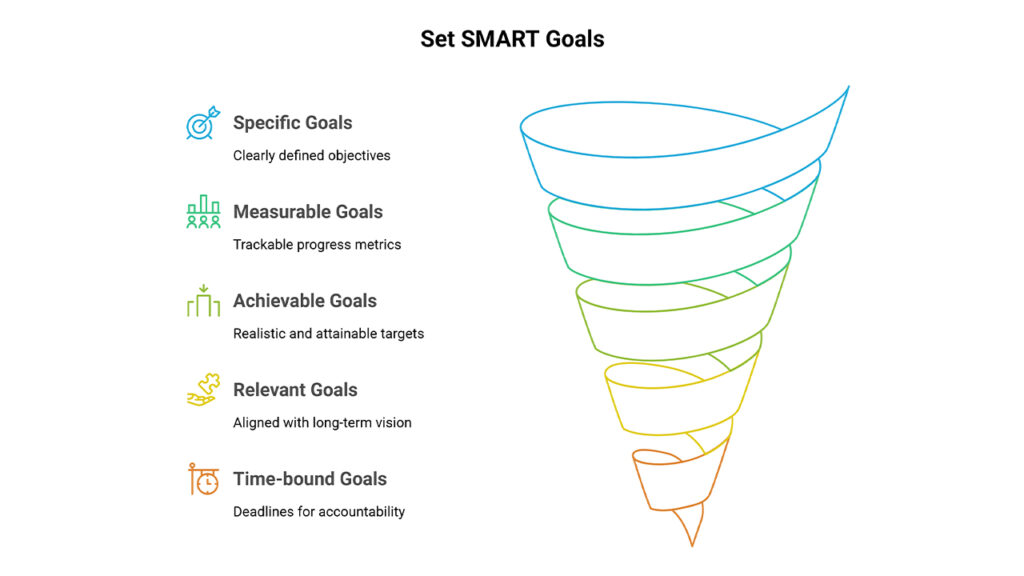
Creating clear business goals is essential for scaling your coaching business. Without them, it’s easy to lose focus and direction. One effective method for setting goals is using the SMART framework. This stands for Specific, Measurable, Achievable, Relevant, and Time-bound goals. Let’s break each part down:
- Specific: Be clear about what you want to achieve. Instead of “I want more clients,” say, “I want to sign 10 new clients for my leadership coaching program.”
- Measurable: How will you track progress? For example, to increase your online presence, set a measurable target like “gain 200 new social media followers in the next month.”
- Achievable: Ensure your goals are realistic. If you’re just starting out, it’s not practical to aim for 100 clients in your first month. Aim for challenging but within-reach goals.
- Relevant: Your goals should align with your long-term vision for your coaching business. If you aim to offer group coaching sessions in the future, your short-term goal might be to increase one-on-one client bookings.
- Time-bound: Set deadlines to keep yourself accountable. For example, “I want to increase my monthly revenue by 20% within the next 3 months.”
Using the SMART framework helps you create focused, actionable, and trackable goals, giving you a clear path forward.
Short-Term vs. Long-Term Goals
While SMART goals guide you toward specific achievements, it’s important to balance short-term and long-term objectives to grow your coaching business steadily.
- Short-Term Goals: These are immediate, actionable targets you can accomplish within weeks or months. They include tasks like setting up your website, creating a coaching package, or booking your first client. Short-term goals keep you motivated and give you quick wins.
Example: “I will create a landing page for my coaching services by the end of this month.” - Long-Term Goals: These are more strategic and may take a year or more to achieve. Long-term goals help you stay focused on your bigger vision. They could include expanding your coaching services, building a larger team, or becoming a recognized expert in your niche.
Example: “I will transition to offering group coaching sessions within the next 12 months.”
Balancing both short-term and long-term goals ensures you’re making daily progress while keeping an eye on the bigger picture. Setting clear goals will act as your roadmap, guiding you through scaling your coaching business.
Step 3: Build a Strong Online Presence
Create a Professional Website
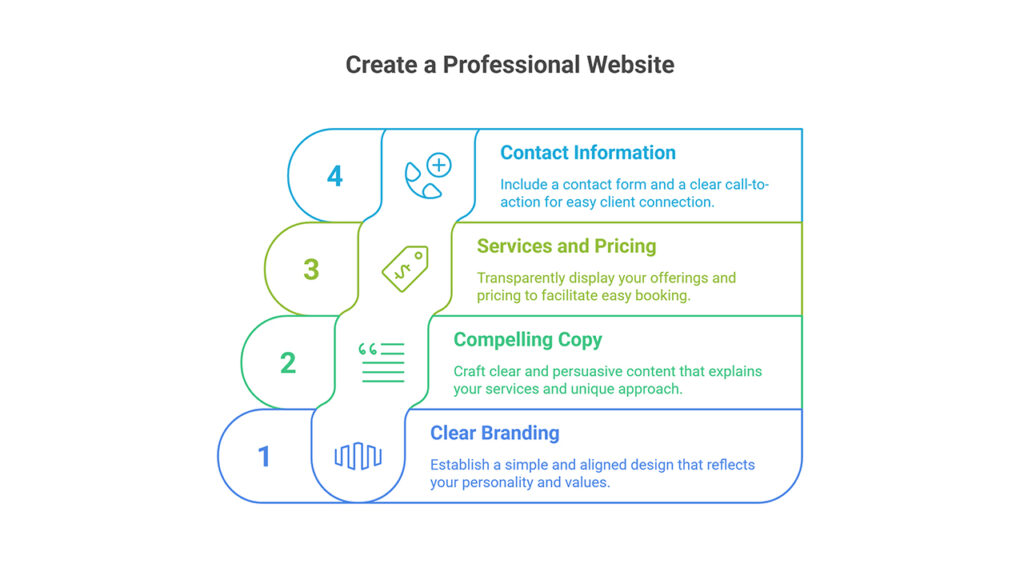
Your website is your first impression, so make it count. It should reflect your coaching style and expertise while being easy to navigate. Here’s what to focus on:
- Clear Branding: Keep the design simple and aligned with your brand. It should communicate your personality and values.
- Compelling Copy: Clearly explain who you are, your services, and why clients should choose you. Highlight your unique approach and qualifications.
- Services and Pricing: Be transparent with your offerings and pricing. Make it easy for clients to book a session.
- Contact Information: Include a contact form and a clear call-to-action like “Schedule a Free Consultation.”
Your website should showcase your value, making it easy for potential clients to connect with you.
Optimize for SEO
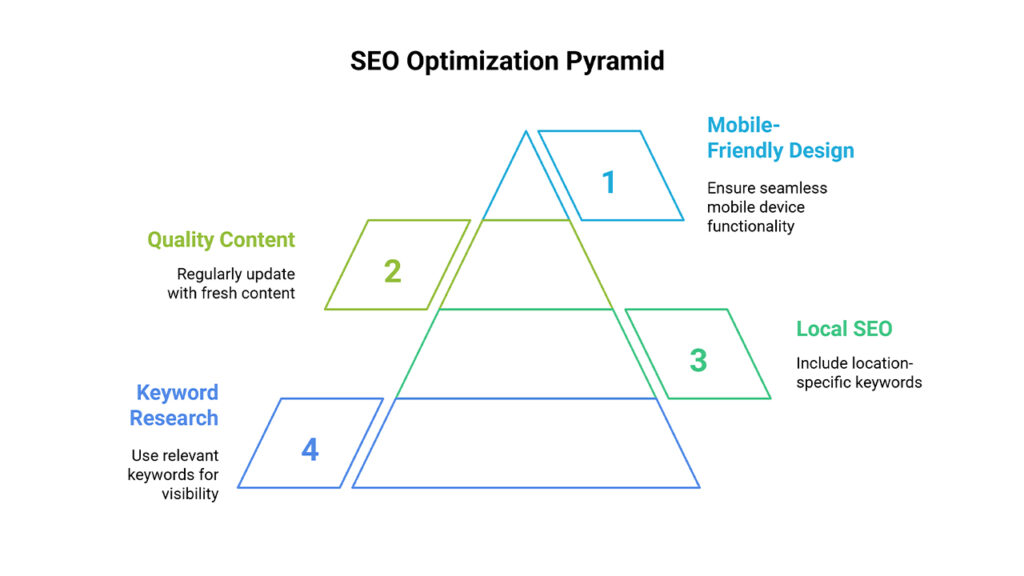
To attract clients, ensure your website ranks on search engines:
- Keyword Research: Use relevant keywords like “leadership coach in Toronto” to improve visibility.
- Local SEO: Include location-specific keywords, like “Toronto,” on your site.
- Quality Content: Regularly update your site with blog posts or client testimonials to keep it fresh.
- Mobile-Friendly Design: Make sure your website works seamlessly on mobile devices.
These SEO basics will help you get found by the right people when they search for coaching services.
Leverage Social Media
Social media is a powerful tool to grow your business and build a community. Here’s how to use it effectively:
- LinkedIn: Optimize your profile for professional networking and share valuable content.
- Instagram: Share success stories, behind-the-scenes content, and motivational posts.
- Facebook: Use a business page to connect with local clients and participate in relevant groups.
Consistency is key. Engage regularly with your followers and establish yourself as an expert in your niche.
Step 4: Develop Your Coaching Programs and Pricing Strategy
Create Structured Coaching Packages
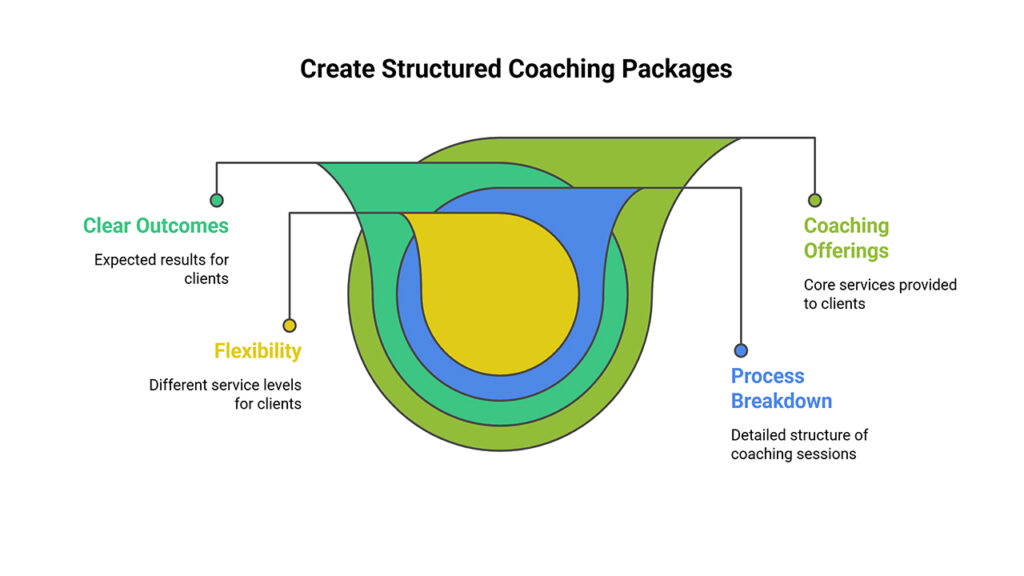
Now that you’ve defined your niche and built an online presence, it’s time to create structured coaching packages that communicate what you offer. A well-structured package helps potential clients easily understand the value you provide and how they’ll benefit from your services. Here’s how to develop effective coaching programs:
- Define Your Coaching Offerings: Decide on the types of coaching you’ll offer. Will you provide:
- One-on-One Coaching: Personalized sessions focused on individual needs.
- Group Coaching: Sessions for multiple clients, fostering a community environment, ideal for areas like leadership or wellness.
- Workshops: These are short-term, high-impact sessions that target specific skills or challenges. They can also serve as an introduction to your services.
- Create Clear Outcomes: Clearly define what clients will achieve from each program. Whether it’s personal growth, career advancement, or mastering a specific skill, make it clear what results clients can expect. This builds trust and sets the right expectations.
- Break Down the Process: Outline how your coaching packages will work. For example, with one-on-one coaching, specify the number of sessions, frequency, and any additional resources you’ll provide. For workshops, describe the schedule, format, and key topics covered.
- Offer Flexibility: Provide different service levels to cater to clients with varying needs and budgets. You could offer basic, intermediate, and premium packages, ensuring you appeal to a wider range of potential clients.
By clearly structuring your coaching offerings, you make it easy for potential clients to understand what they’re getting and position yourself as a trusted professional in your niche.
Pricing Your Services
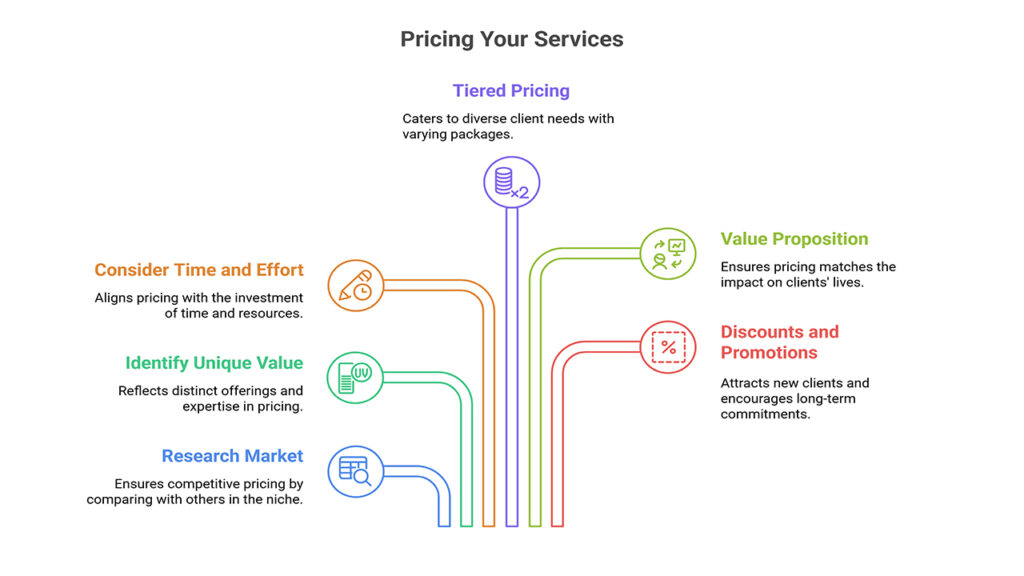
Setting the right price is critical for maintaining a competitive edge and ensuring sustainable business. Here’s how to determine your pricing strategy:
- Research the Market: Look at what other coaches in your niche are charging in Toronto. Compare prices for individual sessions, group coaching, and workshops. This gives you a sense of where you stand in the market and ensures your pricing is competitive.
- Identify Your Unique Value: What makes your coaching different from others? Whether it’s your approach, specific expertise, or the results you’ve achieved with clients, your pricing should reflect the unique value you offer.
- Consider Your Time and Effort: Account for how much time and effort go into each program. For example, one-on-one coaching will require more preparation and follow-up than a group session. Factor these elements into your pricing to ensure it aligns with your investment time.
- Tiered Pricing: Consider offering multiple pricing tiers to meet varying client needs. For example:
- Basic Package: A single coaching session at a lower price point.
- Mid-Tier Package: A bundle of 5-10 sessions with a discount.
- Premium Package: Comprehensive coaching with follow-ups, extended access, and personalized services.
- Value Proposition: Ensure your pricing aligns with the value you’re providing. If your coaching is making a significant impact on clients’ lives, your pricing should reflect that.
- Discounts and Promotions: Consider offering special pricing for new clients or during a promotional period. You could also offer discounts for referrals or long-term commitments, incentivizing clients to stay longer or bring in others.
By pricing your services appropriately, you ensure that you remain competitive while valuing your time and expertise. A strong pricing strategy helps you attract clients and build a profitable coaching business in Toronto.
Step 5: Set Up Business Infrastructure
Business Structure
Choosing the right business structure is one of the first decisions in starting your coaching business. This affects your taxes, liability, and long-term growth potential. Here are your two main options:
- Sole Proprietorship: This is the simplest structure. As a sole proprietor, you manage everything—your income is taxed directly, and you’re personally responsible for any debts. It’s ideal if you’re starting small and want to keep things straightforward. However, you’re personally liable for any legal issues, which means your assets could be at risk.
- Incorporation: If you plan to grow your business or hire employees, incorporating might be a better choice. Incorporating separates your assets from your business, limiting your liability. However, you’ll have more paperwork, including filing separate tax returns for your business. Incorporation is also useful if you’re considering investment or expanding significantly.
Your decision depends on your business goals, how much risk you’re willing to take, and how you plan to scale. If you’re unsure, consulting with a financial advisor or lawyer can help you make the right choice for your situation.
Legal and Financial Essentials

To run your business smoothly and stay compliant, here are the key legal and financial essentials to consider:
- Licenses and Permits: You may need a business license or permit depending on your location and business type. In Toronto, you might require a general business license to operate. Make sure to check local regulations to stay compliant.
- Contracts: Always use clear contracts for every coaching program, whether one-on-one sessions, group coaching, or workshops. Contracts define the terms of service, payment schedules, and scope of work, protecting you and your clients. Contracts help prevent misunderstandings and ensure everyone is on the same page.
- Bookkeeping Tools: Track your finances from day one. Use tools like QuickBooks or FreshBooks to track income, expenses, and taxes. These tools help ensure you’re ready for tax season and give valuable insights into your business’s financial health. It’s also important to keep a separate business account for easy tracking.
- Insurance: Consider investing in business insurance to protect against unforeseen issues like client lawsuits or property damage. Insurance provides peace of mind and helps safeguard your assets from business-related risks.
Setting up these essential systems allows you to focus on growing your business without worrying about legal or financial mishaps.
Step 6: Implement Effective Marketing Strategies
Content Marketing
Content marketing is one of the most effective ways to attract clients and position yourself as an expert. You can build trust and connect with your target audience by consistently sharing valuable content. Here’s how to get started:
- Blogging: Blogging helps showcase your expertise and gives potential clients a glimpse into your coaching style. Write about common problems your audience faces and provide actionable solutions. For instance, if you’re a wellness coach, you might write about stress management or how to build a healthier routine. Ensure your blog is SEO-friendly to improve its visibility and attract organic traffic.
- Videos: Videos are a powerful way to engage with potential clients personally. Create short videos where you offer coaching tips or answer frequently asked questions. Posting on platforms like YouTube and Instagram allows you to reach a broader audience and build credibility through visual content.
- Podcasts: Starting a podcast is another excellent way to share your expertise and connect with your community. Share insights, interview clients or other experts, and discuss relevant topics in your niche. Podcasts allow you to build a loyal following and position yourself as a thought leader.
Consistently creating valuable content helps you attract people actively seeking solutions and strengthens your authority within your niche.
Paid Advertising
While content marketing helps you grow in the long run, paid advertising can deliver quicker results. Here’s how you can use ads to target your ideal clients in Toronto:
- Google Ads: You can target people actively searching for coaching services. For example, if someone searches for “leadership coach Toronto” or “wellness coaching Toronto,” your ads can appear, putting you in front of clients ready to take action.
- Facebook and Instagram Ads: These platforms offer targeted advertising based on location, interests, and behavior. Create compelling ads that speak directly to your ideal clients. For instance, if you specialize in business coaching, run ads for Toronto professionals interested in leadership and entrepreneurship. Video ads are especially effective in showcasing your services.
Paid advertising can drive immediate traffic to your business, but monitoring performance and adjusting campaigns to ensure you’re getting the best return on investment is important.
Networking and Referrals
Building relationships within your industry and local community can generate valuable referrals and help grow your business. Here’s how to leverage networking:
- Networking Events: Attend local business events, workshops, and meetups in Toronto. Not only will you meet potential clients, but you’ll also form relationships with other professionals who can refer clients to you. Whether a business breakfast or a wellness fair, networking allows you to connect with others and gain exposure.
- Referral Programs: Word-of-mouth is one of the most powerful ways to grow your client base. Set up a referral program where existing clients can refer others in exchange for a discount or free session. Make it easy for clients to recommend you by offering them something of value.
Networking and referrals are built on trust, making them incredibly powerful tools for attracting new clients. When someone recommends your services, it’s often more convincing than any ad or promotion.
Step 7: Streamline Operations with Automation and Delegation
Automate Routine Tasks
As your coaching business expands, handling everything manually can become overwhelming. That’s where automation tools step in. By automating key business areas, you can reduce errors, save time, and focus on what truly matters—coaching your clients. Here’s how to streamline operations:
- Email Marketing: Use tools like Mailchimp or ConvertKit to automate email campaigns. These tools allow you to set up automated welcome emails for new subscribers, nurture sequences for leads, and regular newsletters to stay in touch with clients without constant manual effort.
- Client Scheduling: Tools such as Calendly or Acuity Scheduling allow clients to book online sessions. These tools sync with your calendar, enabling clients to choose times that work for both of you, eliminating the need for back-and-forth emails.
- Payment Processing: Platforms like Stripe and PayPal streamline payment processing, making it easy for clients to pay for sessions through your website or scheduling tools. They track finances and generate receipts, helping you stay organized without extra work.
By automating these processes, you reduce your workload, enabling you to focus more on coaching while the tools handle routine administrative tasks.
Delegate Non-Core Activities
Once you’ve automated key processes, consider delegating tasks that don’t require your direct involvement. Here’s when and how to start delegating:
- When to Delegate: If you spend more time on administrative tasks, such as bookkeeping or social media management, than on coaching, it’s time to start outsourcing. This frees you up to focus on growing your business and working with clients.
- Outsource Key Tasks:
- Social Media Management: If social media engagement consumes time, hire someone to manage posts, interact with followers, and maintain an active online presence.
- Bookkeeping: Hire a professional to handle taxes, invoicing, and expenses. This will keep your finances organized and ensure that deadlines are met.
- Client Administration: As your client base grows, outsource tasks like client intake forms, communications, and progress tracking to ensure smooth operations.
Step 8: Focus on Client Retention
Personalized Coaching
Retaining clients is about offering tailored, individualized support that meets their needs. Here’s how you can build strong, long-term client relationships through personalized coaching:
- Understand Their Goals: Take the time to ask each client about their unique goals and challenges. The more you know about their journey, the better you can design coaching plans that resonate with them.
- Create Customized Plans: Move away from a one-size-fits-all approach. Instead, build personalized coaching plans. For example, if you’re a wellness coach, one client may benefit from stress management techniques, while another may need fitness-based strategies. Personalized coaching shows clients that you’re invested in their success.
- Check-in and Adjust: Regular check-ins help ensure your clients are making progress. Adjust your approach if needed, based on how they evolve or face new challenges. This will show your clients that you care about their ongoing development.
Engagement Strategies
Once you have personalized your coaching, it’s important to consistently engage your clients to keep them motivated and connected to your services:
- Follow-ups: After each session, email a follow-up summarizing key takeaways, action steps, and any tasks or homework. Regular follow-ups help clients stay on track and remind them of the value they’re receiving from your coaching.
- Progress Tracking: Track their progress through shared documents or coaching apps. Celebrate milestones and small victories to maintain motivation and a sense of accomplishment.
- Ongoing Support: Continue providing valuable resources, articles, and motivational content between sessions. This helps maintain a positive connection and keeps clients engaged with your services even when not in a session.
Combining personalized coaching with ongoing engagement creates a relationship where clients feel supported and are more likely to return for continued coaching.
Step 9: Expand by Building a Support Team
As your business grows, it becomes clear that you can’t manage everything alone. This is the stage where you need to hire additional support to help you scale. Here’s how to know when it’s time to bring in help and how to build a strong team:
When to Hire
Here are signs that indicate it’s time to hire:
- Overwhelmed with Tasks: If you spend more time on administrative work than on coaching, it’s time to bring someone on board to help with the non-coaching tasks.
- Consistent Client Demand: If your client list is growing quickly and you’re struggling to keep up, you need additional support, such as more coaches or administrative staff.
- Marketing or Content Creation is Slipping: If you’re falling behind in marketing or content creation due to time constraints, hiring a marketing expert or virtual assistant can help maintain your business’s visibility.
Building Your Team

Here’s how to build a successful team:
- Start Small: Begin by hiring part-time help or contractors. Consider virtual assistants, marketing experts, or additional coaches. This allows you to test the waters before committing to full-time staff.
- Ensure Alignment: When recruiting, ensure new hires align with your coaching philosophy and values. They should understand the importance of maintaining high-quality service.
- Define Roles and Responsibilities: Ensure everyone understands their tasks to avoid confusion and smooth operations.
- Provide Ongoing Training: Invest in regular training to maintain consistency and high service standards as your team grows.
Hiring and delegating tasks will allow you to focus on scaling your business without sacrificing service quality. Building a strong team ensures continued growth and the ability to offer personalized coaching at scale.
Step 10: Monitor, Analyze, and Adjust Your Strategy
Now that you’ve built a team and streamlined your operations, it’s crucial to track your business’s progress and refine your strategy. This step focuses on measuring key performance metrics, analyzing results, and adjusting your approach to ensure continued growth.
Track Key Metrics:
- Revenue Growth: Monitor your earnings regularly to ensure consistent growth. Look for trends and adjust your offerings or pricing if necessary.
- Client Satisfaction: Use surveys and direct feedback to assess how happy clients are with your services. Satisfied clients are more likely to return and refer others.
- Marketing Performance: Track metrics like website traffic, social media engagement, and conversion rates to determine which marketing strategies work. Use this data to adjust campaigns and make smarter marketing decisions.
Adapt and Evolve:
- Analyze What’s Working: Focus on the strategies generating the best results. For instance, if client referrals or specific content types drive traffic, focus on those.
- Adjust When Needed: If a marketing tactic or business strategy isn’t delivering the desired results, be prepared to pivot. Changing course is a normal part of business growth.
- Stay Open to New Ideas: As trends in coaching and marketing evolve, be proactive in learning new tools, techniques, or strategies to enhance your business.
Tracking your business’s key performance indicators (KPIs) and remaining flexible will allow you to refine your strategy and continuously stay on the growth path.
Conclusion
Scaling a coaching business in Toronto may seem daunting, but with the right strategies, it becomes an exciting journey of growth and opportunity. By defining your niche, setting clear goals, and building a strong online presence, you’re laying the groundwork for sustainable success. Effective marketing, personalized coaching, and a well-structured pricing strategy will help you attract and retain clients, while automation and delegation free up your time to focus on what matters most—delivering value to your clients.
As you expand your coaching business, remember that building a support team and refining your strategy is essential for long-term growth. The ability to adapt, track your progress, and adjust your approach as you learn will keep you ahead of the competition. Scaling isn’t just about growing bigger—it’s about growing smarter, maintaining quality service, and continually offering meaningful support to those you coach.
With the right mindset and approach, your coaching business can thrive in Toronto’s competitive market and become a fulfilling and impactful enterprise that transforms lives. Keep pushing forward, stay focused, and watch your coaching practice reach new heights.





